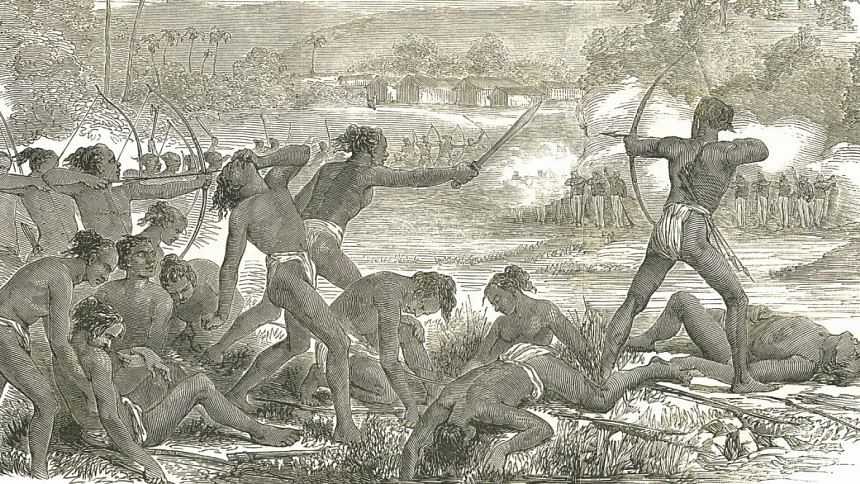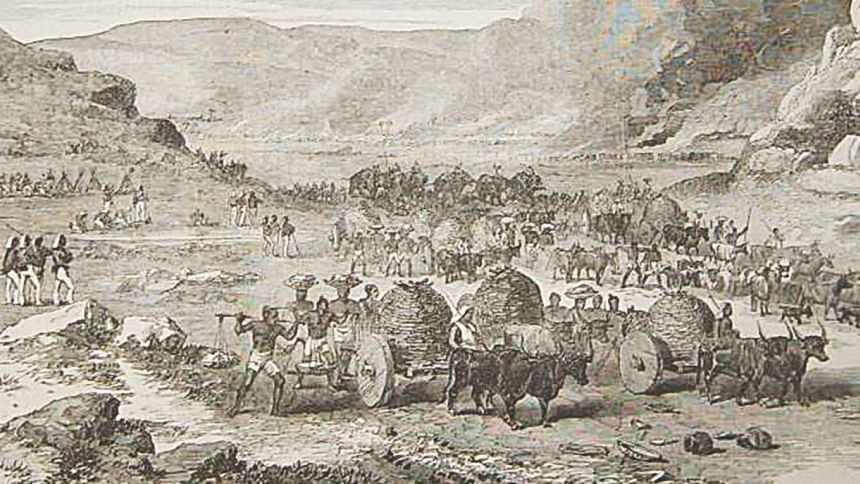When the Santhals rebelled

"It was not war; they did not understand yielding. As long as their national drum beat, the whole party would stand, and allow themselves to be shot down. Their arrows often killed our men, and so we had to fire on them as long as they stood. When their drum ceased, they would move off a quarter of a mile; then their drums beat again, and they calmly stood till we came up and poured a few volleys into them. There was not a sepoy in the war who did not feel ashamed of himself."
The Scottish historian William Wilson Hunter, who was also a member of the Indian Civil Service, in his book Annals of Rural Bengal recorded the first hand testimony, quoted above, of officers, who with the military might of the British Raj, put down the Santhal Rebellion (also known as the Santhal Hool). June 30 marks the 161stanniversary of the day when the Santhals, choking under the pressure of practical serfdom due to the mahajani system, and with none of their grievances given importance by the administration, rose in revolt and demanded autonomy.
The Santhals, one of the oldest communities to make their home in Bengal, were largely agrarian people, who lived in and depended on forests. After the British Raj had taken over the administration of India, and taxes were levied on their traditional ways of living, small outbreaks of revolt had taken place, as they faced oppression from tax-collecting mahajans and zamindars. In 1832, the government demarcated the Damin I Koh region in present day Jharkhand in India and invited Santhals to settle in the area in order to reclaim the forest. A great exodus of Santhals from Cuttack, Dhalbhum, Manbhum, Hazaribagh, Midnapore etc. came to settle in the reserve due to promises of land and other economic amenities.
But the government had other plans in mind:"to ascertain what profits are now derived from the land." (Bhagalpur Commissioner Report, 1836) The missionaries on the other hand sought their beliefs, hoping that "Christianity take firm root . . . in the forest and wilds of Rajmahal hills." (Letter from the commissioner of Bhagalpur to the secretary of the government of Bengal, 1836) Soon, mahajans and zamindars as tax-collecting intermediaries dominated the economy and the lives of the region.
The Santhals have traditionally been described as peace loving, naïve people who had not learnt to lie. Their low literacy made them easy victims to corrupt money lending practices. Their lands were forcibly taken, they were lent money at exorbitant rates which they could never repay, they were forced into bonded labour, and generation after generation of Santhals had to live as serfs, cultivating the zamindar's land for little food and clothes. Many had no other recourse than to work for Indigo planters or for the frenzy of railway constructions that the British initiated.

They had no recourse to the administration either. While the British lauded themselves on 'civilising the natives', the bureaucracy, the police, the court were all staunchly against the welfare of the Santhals. In 1855, under the leadership of two brothers, Sidhu and Kanoo, who mobilised 10,000 Santhals, they declared rebellion. It is important to note that first they had tried to settle their grievances through official channels, and only when they received no reply from the 'cheap and practical administration' (Hunter), did they decide to march in revolt.
What happened next was armed mutiny. The rebels decided to banish all traders and zamindars from their country, and demanded autonomy. Fights broke out, as the zamindars tried to retain their hold, and there were casualties on both sides. When news of their activities reached the administration, it sent troops to quell the rebellion. Against the bows and arrows came guns and thousands were shot down. Elephants were used to systematically destroy their villages. As Karl Marx observed in his Notes on Indian History, "Outbreak of the Santal, a half-savage tribe, in the Rajmahal Hills in Bengal; put down, after seven months' guerrilla warfare, in February 1856."
And yet, much of what has been written, remembered and interpreted of the Santhal Rebellion of 1855 has been appropriation, first by the colonial British historians and then by the post-partition Indian national historians. Ranajit Guha observes how British historians, like Hunter, appropriated the rebellion as just another event in the "life-story of the Empire. . . The rebel has no place in this history as the subject of rebellion." Hunter, though sympathetic to their plight, took the event as a life-lesson on how to make the British administration better and how the British enterprise was the answer to solving the problems of the natives. Guha further points out how post-independence historians later identified the rebellion as a pre-cursor to India's struggle for independence. What had been a conscious revolt of a people who took up arms demanding basic rights, was used as a tool for nationalist historiography: "all the popular struggles in rural India during the first hundred and twenty-five years of British rule [were appropriated] as the spiritual harbinger of the Indian National Congress."(The prose of counter-insurgency, Subaltern Studies II) The Santhals demand for autonomy for themselves was at once lost and reinterpreted, for the 'greater good' of nationalist uprising, as Congress's demand of independent India.
Indeed, peasant movements and revolts were, and are, often put down in history as spontaneous movements, when uneducated, apolitical groups of people break forth in anger, like natural phenomenon, and not as conscious decision makers. But, the Santhals of the Rajmahal Hills of Bengal did not revolt on a whim. The oppression on the Santhals, and other indigenous communities, has festered into open rebellion over and over again. The earlier revolts of Santhal leaders such as Paru Raja in Dinajpur, the Tebhaga or the Tonko movements, or the Munda rebellion of 1900, had all been mass movements by these communities to address their grievances, to claim what was theirs, and against the stripping of their ownership of land and being made tenants to rich mahajans and zamindars.

Hunter praised the British government on making bonded labour illegal and providing them work in the railways and in tea plantations. Yet, bonded labour continued well into independent India, and tea-plantations only exploited the cheap indigenous labour. Nationalist history commemorates the struggle of the Santhal in the grand narrative of independence from the British, and yet did little to right the wrongs done to them.
Forced eviction from their lands, exploitation and discrimination from the middle and rich classes led to the Hool. However, has much changed, even as India erects statues of indigenous leaders and nationalist historians commemorate their contribution to independence? In Bangladesh, reports claim different numbers of the Santhal population—but all show that it is on a sharp decline. The majority of them, according to historian Mesbah Kamal (more than 60 percent), remain landless. They are discriminated socially, politically and economically. They still struggle to make authorities hear their plight as they try to keep hold of their khas lands, and money lenders exploit their poverty. What writer Mahasweta Devi described as the plight of the Munda's in her book Chotti Munda Ebong Tar Teer (Chotti Munda and his arrow), is representative of Santhals and most other indigenous communities even today: governments change, promises are made, and yet, it is the capitalist classes which ultimately have their way. Only in 2000, "musclemen of Local landlords—Hatem Ali and Shitesh Chandra Bhattacharya—killed Alfred Soren [a Santhal leader] at Bhimpur in Naogaon district as he tried to resist their bid to evict 22 indigenous families from the village." Justice for Soren is yet to be served.
In truth, the administration has never been kind to these indigenous communities. The recent incidents in Banskhali and Nahar Punji speak of the same injustices: deprivation of land, forceful evictions and helplessness within the state machinery. Just this month more than 700 Khasi people were given eviction notices from their ancestral land. The colonial laws, with their added amendments, have now made these communities encroachers in their own land—the question of land still haunts the lives of these communities.
Santhals in Bangladesh and in India still celebrate the Hool and remember their leaders Sidhu and Kanoo every year, their songs speak of the time when they laid down their lives for their rights. And the state continues to exploit these people, depoliticising and appropriating their history, making them footnotes and denying them agency. Their demands of recognition as adivasis remain unheeded. Last year, in a celebration of the Hool, the Jatiya Adivasi Parishad (JAP) president Rabindranath Soren said, "Indigenous people face various types of discrimination while land grabbers are becoming more and more desperate to occupy their lands in absence of justice."
In this context, the Santhal Rebellion of 1855 remains relevant today. More than a celebration of historical bravery, it is a reminder of what Sidhu and Kanoo fought for, and what is yet to be achieved.
The writer is a member of the editorial team, The Daily Star

 For all latest news, follow The Daily Star's Google News channel.
For all latest news, follow The Daily Star's Google News channel. 



Comments